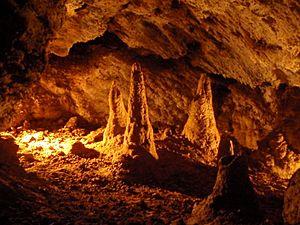Zbrasov aragonite caves facts for kids
The Zbrašov aragonite caves are amazing underground spaces in the Czech Republic. They are a special protected area. These caves were formed by both rain water from the surface and warm mineral water from deep underground. The warm mineral water is full of carbon dioxide. People use this water for spa treatments in the nearby town of Teplice nad Bečvou.
Inside, you'll find beautiful rock formations made of aragonite. Some stalagmites look like mini geysers, and others look like doughnuts! The lowest parts of the caves are filled with carbon dioxide gas. The temperature inside the caves stays at 14°C (57°F) all year round. This makes them the warmest underground caves in the Czech Republic. The caves were first found in 1912 and opened for visitors in 1926.
Contents
Where Are the Caves?
The Zbrašov aragonite caves are located right next to the Bečva River. They sit about 250 to 310 meters (820 to 1,017 feet) above sea level. These caves are part of a larger karst area. A karst area is a place where the ground is made of rock that can dissolve, creating caves and sinkholes. This area also includes the Hranická gap, which is the deepest hole in the Czech Republic. It's just across the Bečva River.
Some buildings in the area used to cause problems for the cave system. But now, work is being done to connect them to a proper sewer system. This will help protect the caves from pollution.
How Were the Caves Found?
In December 1912, some workers were digging at a local quarry. They found a crack in the rocks, and warm air was coming out of it! Two brothers, Josef and Čeněk Chrome, were very interested in the caves and rocks in the area. They made the opening bigger.
In January 1913, the brothers bravely climbed down a rope into the dark space. They went about 42 meters (138 feet) down. But then, their rope broke! Their lamp also broke when they fell. They were stuck in the dark for eight hours before they were rescued. Over the next few years, many more parts of the 1,322-meter (4,337-foot) long cave system were explored.
A new entrance to the cave was dug from the Bečva valley. Electric lights were put in, and in 1926, the caves were opened to the public. From 2002 to 2005, the caves were updated. The walking paths and wiring were replaced. A lot of rock and dirt that had been left inside from the original digging was finally removed. This made some parts of the caves look like they did naturally.
How the Caves Were Formed
The area around the caves has huge blocks of rock. The valleys are short and follow lines where the rocks have cracked. There's a very thick layer of Devonian limestone, more than 500 meters (1,640 feet) deep. This is covered by a younger layer of Miocene sediments.
The Zbrašov caves were formed in two different ways. First, rainwater seeped into cracks in the limestone. This slowly dissolved the rock and created large underground rooms. Second, warm mineral water came up from deep underground, sometimes from as far as 2 kilometers (1.2 miles) down!
The beautiful formations in the cave are mostly made of calcium carbonate. This mineral can form in different ways:
- Calcite: This is the most common type. It forms many cave features like stalactites (hanging from the ceiling), stalagmites (growing from the floor), and other deposits. The unique geyser stalagmites are cone-shaped and are found only here!
- Aragonite: This forms white, needle-like crystals. It happens when water and carbon dioxide are released from the mineral water.
Water in the Caves
The Bečva River drains the area and flows into the Morava River. When there's a lot of rain, the river can flood. A very big flood happened in July 1997. The floodwater got into the caves, even reaching the Marble Hall. This also made the levels of the mineral pools rise, and carbon dioxide gas reached higher parts of the caves. To keep visitors safe, a special fan system was installed. It helps keep the air safe by removing extra carbon dioxide. The floods damaged some of the equipment, but luckily, they didn't harm the natural beauty of the caves.
The warm mineral water from the caves is used in spas. There are two main springs and two deep boreholes (wells) that bring up this water. The water is full of minerals and is lukewarm, usually around 22.5°C (72.5°F). This mineral water is used for special spa treatments. These treatments help people with problems like issues with their circulatory system or metabolism.
Images for kids








